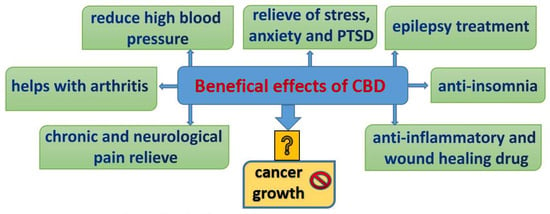Abstract
The success of cannabinoids with chronic neuropathic pain and anxiety has been demonstrated in a multitude of studies. With the high availability of a non-intoxicating compound, cannabidiol (CBD), an over-the-counter medication, has generated heightened interest in its use in the field of oncology. This review focuses on the widespread therapeutic potential of CBD with regard to enhanced wound healing, lowered toxicity profiles of chemotherapeutics, and augmented antitumorigenic effects. The current literature is sparse with regard to determining the clinically relevant concentrations of CBD given the biphasic nature of the compound’s response. Therefore, there is an imminent need for further dose-finding studies in order to determine the optimal dose of CBD for both intermittent and regular users. We address the potential influence of regular or occasional CBD usage on therapeutic outcomes in ovarian cancer patients. Additionally, as the development of chemoresistance in ovarian cancer results in treatment failure, the potential for CBD to augment the efficacy of conventional chemotherapeutic and epigenetic drugs is a topic of significant importance. Our review is focused on the widespread therapeutic potential of CBD and whether or not a synergistic role exists in combination with epigenetic and classic chemotherapy medications.

Keywords: cannabinoids, chemoresistance, endocannabinoid system, epigenetic therapy, ovarian cancer, phytocannabinoids, targeted therapy
Conflict of interest statement
The authors declare no conflict of interest.
References
-
- NIH National Cancer Institute. Surveillance, Epidemiology, and End Results Program. Ovarian Cancer. [(accessed on 3 May 2021)]; Available online: https://seer.cancer.gov/statfacts/html/ovary.html.
-
- Chi D.S., Berchuck A., Dizon D.S. Princ Pract Gynecol Oncol Seventh Ed Lippincott Williams Wilkins; Principles and Practice of Gynecologic Oncology, 7th edition, 2017. Classification: LCC RC280.G5|NLM WP 145|DDC 616.99/465–dc23 LC. [(accessed on 3 May 2021)]; Available online: https://lccn.loc.gov/2016048223.



